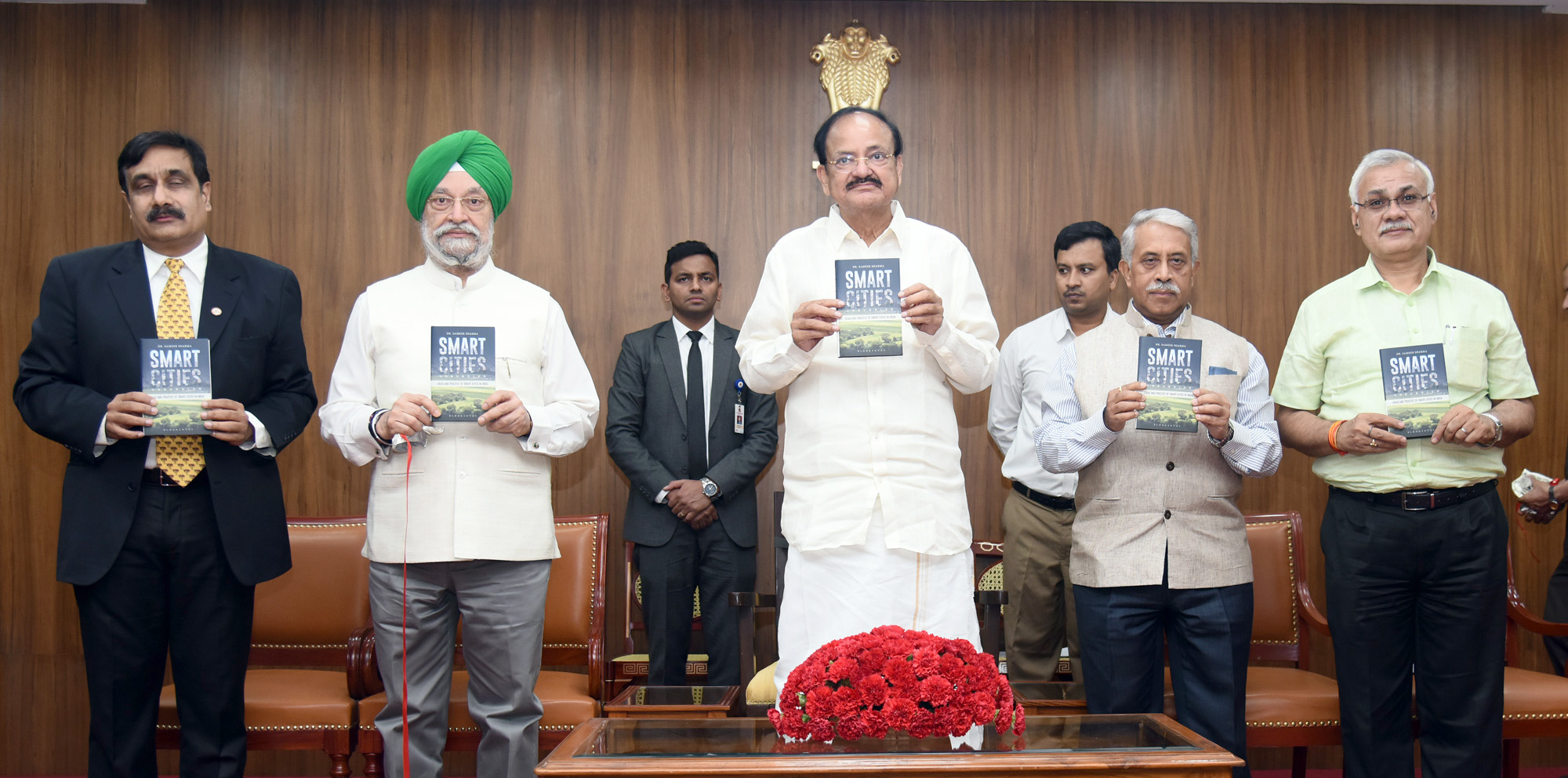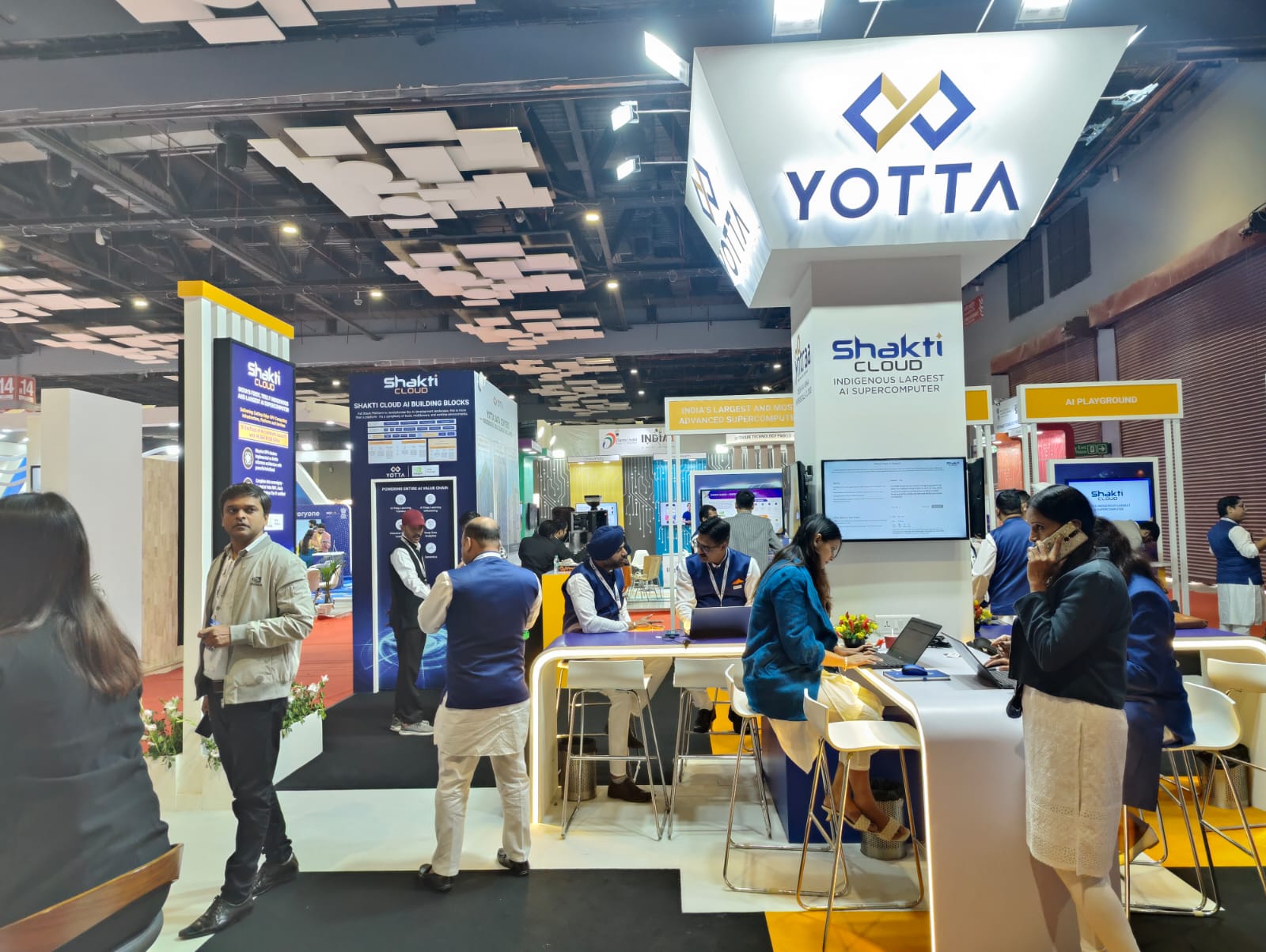News
Smart Cities Mission is the beginning of India’s urban renaissance: Vice President


The Vice President,M. Venkaiah Naidu releasing the Book Smart Cities Unbundled authored by Dr. Sameer Sharma, in New Delhi on April 25, 2018.
The Minister of State for Housing and Urban Affairs (I/C), Hardeep Singh Puri, the Secretary, Ministry of Housing and Urban Affairs, Durga Shanker and other dignitaries are also seen.
NEW DELHI: The Vice President of India, M. Venkaiah Naidu has said that the Smart Cities Mission is the beginning of India’s urban renaissance.
He was addressing the gathering after releasing the Book ‘Smart Cities Unbundled’ authored by Dr. Sameer Sharma, here.
The Minister of State for Housing and Urban Affairs (I/C), Hardeep Singh Puri and other dignitaries were present on the occasion.
The Vice President said that a Smart City is a liveable city to the people with required amenities like clean drinking water, sanitation, toilets, infrastructure etc.
He further said that it as a renaissance because there has been a paradigm shift in both the planning, approach and implementation of Smart City mission.
The Vice President said that while the government has a Constitutional mandate to devolve funds, functionaries and functions on local bodies, the progress has been slow.
He further said that the urban agenda prepared by the present Government aims to address this gap by integrating several types of plans at the city level.
People’s participation in any programme is crucial for its success, he added.
The Vice President said that the Smart Cities Mission, which was described as ‘Mission Transform nation’ by the Prime Minister, Shri Narendra Modi, seeks to transform cities into sustainable centres of economic activity and provide improved quality of life to citizens. He further said that another remarkable feature of the mission was to take up credit rating of cities. One more important strategic element of the Smart Cities Mission is the use of digital technology to bring about transparency and accountability, as well as improving the service delivery to its citizens, he added.
The Vice President said that a novel feature of Smart Cities Mission is Area Based Development – cities pick up one area, develop it fully and then proceed to develop all other areas of the city one by one. He further said that making the Urban Local Bodies financially self-sufficient is very important for sustainable development.
This new initiative requires a new skill set, an ability to access and utilize the state of the art from around the world and an attitudinal shift where we forge new partnerships and collaborations rather than executing project only by the government, he added.
Following is the text of Vice President’s address:
“For me, Smart Cities Mission is the beginning of India’s urban renaissance. I am describing it as a renaissance because there has been a paradigm shift in both the planning, approach and implementation of this mission.
From this ‘top down’ planning approach to a ‘bottom-up’ planning approach, from merely waiting for funds to flow from the Union and State governments to creatively generating funds through bonds and value capture finance and public private partnership, it has been a paradigm shift.
While the government has a Constitutional mandate to devolve funds, functionaries and functions on local bodies, the progress has been slow. However, it is heartening that in a threefold increase over that of the 13th Finance Commission, the 14th Finance Commission awarded total grants of Rs.87,114 Crore to Urban Local Bodies.
Post independence, economic planning was done at the national level by the Planning Commission. Earlier, there was hardly any connection with spatial planning at the city and regional levels. The urban agenda prepared by the present Government aims to address this gap by integrating several types of plans at the city level.
The vehicle to do this is the Smart City Challenge – a competition in which more than 14 million people participated to discuss and decide on the future of cities. This was a unique concept as it enabled a participatory role to the people in deciding about the future of their cities.
I am happy to note that the City of Bhubaneswar which stood first in the competition has been given an international award by the American Planning Association. In the top 20 global Smart Cities ranked by the British market research agency Juniper Research, Bhubaneswar again finds a place.
The Smart Cities Mission, which was described as ‘Mission Transform nation’ by the Prime Minister, Shri Narendra Modi, seeks to transform cities into sustainable centres of economic activity and provide improved quality of life to citizens. The Mission saw a complete shift in the urban development planning in the country as “bottom-up” approach was adopted as against Delhi-driven ‘top-down’ method which used to be followed till then.
Another remarkable feature of the mission was to take up credit rating of cities. The Government have started a campaign to do the credit rating of cities. This exercise to understand the financial health of our urban local bodies by credit rating has been completed in 348 cities. I am happy to note that 146 cities have “Investment Grade” with more than BBB(minus) grades and 30 cities with more than A(minus) grades.
One more important strategic element of the Smart Cities Mission is the use of digital technology to bring about transparency and accountability, as well as improving the service delivery to its citizens. In the Smart Cities Mission, cities are rolling out fast network of sensors and cameras to collect data, which is then analysed by using artificial intelligence to make predictions and decisions regarding collection of solid waste, traffic management, control of crime, etc.
In fact, cities are using digital technology to build a nervous system for our cities. This is an invisible and magical weapon which will make life more convenient for all the people. I am happy to note that Smart City Centres have already been completed in 8 cities; Ahmedabad, Kakinada, Visakhapatnam, Nagpur, Pune, Rajkot, Surat, and Vadodara. 15 more Smart City Centres are under construction and another 31 are in the tendering stage.
Another novel feature of Smart Cities Mission is Area Based Development – cities pick up one area, develop it fully and then proceed to develop all other areas of the city one by one. The reason is that,“Areas” in India are so different — the local plan for development of Paharganj in Delhi will be very different from that of Greater Kailash. The selection of Areas and the components to be developed within the area are done by the citizens. Work has started in Udaipur and Ujjain on integrated Area Based Development.
Several cities have started to develop smart streets as part of Area Based Development. In smart streets, different activities on the streets are re-organised so that all get a place. In the completed streets of Pune and Surat, there is marked difference in the visual aesthetics and optimal utilisation of space.
Making the Urban Local Bodies financially self-sufficient is very important for sustainable development. I am happy to note that Pune and Ahmedabad have issued Municipal Bonds and the proposals of another eight cities are in an advanced stage to issue the bonds.
Another financial tool, having a large potential is Value Capture Finance (VCF). Government invests a lot of money in cities, which leads to increase in property values. Government policies also have a positive effect on house values. In Value Capture Finance, a small share of this increase in property value due to actions by Government is taken by the local bodies for constructing public projects. I am happy to note that 17 cities are in an advanced stage of formulating Value Capture Finance policies and creating bye-laws to implement them.
Smart cities have caught the imagination of the world. Countries are attempting to make a couple of cities smart or, perhaps, half-a-dozen. India has set itself a target of 99 Smart Cities which will act as Lighthouses for other cities to follow. The programme and its multiplying effects are much larger.
Clearly, this new initiative requires a new skill set, an ability to access and utilize the state of the art from around the world and an attitudinal shift where we forge new partnerships and collaborations rather than executing project only by the government.
The wave of urbanization is unstoppable.
All that we have to do is to use this as an opportunity to transform the way we manage this historical trend.
In many ways, we have lost a lot of time, probably, but it is never too late.
We have to give a new impetus to systematic urban planning, sustainable funding and swifter execution.
There is a need for upgrading the professional competence of civil servants to enable a more competent handling of urban management.
A more people-centric, transparent governance using technological tools as well as a humane, and objective, interface is the need of the hour.
The essence of ‘smartness’ is efficiency, effectiveness, excellence and empathy. It is governing our cities with people at the very centre of the whole system.
Dr. Sameer Sharma, who was the Mission Director for Smart Cities Mission, Atal Mission for Rejuvenation and Urban Transformation (AMRUT) and Capacity Building programme from 2014 to 2017 is publishing the story of this journey. The book is aptly titled as Smart Cities Unbundled because we have to tell India and the world what an Indian Smart City is and what constitutes Smart Cities Mission of India.
News
Yotta’s Cloud Data Center in GIFT City, Gujarat goes live

NEW DELHI: Yotta Data Services, an end-to-end Digital Transformation service provider, has announced that its state-of-the-art data centre facility, “Yotta G1”, located in GIFT city, Gandhinagar is ready for service (RFS).
The opening of this data center marks the debut of Yotta in Gujarat and progresses the company’s mission to provide digital services in India’s high-growth markets.
G1 is Yotta’s fifth data center facility in the country. It joins four large operational data centers, two of which, at Navi Mumbai and Greater Noida are part of hyperscale campuses. Yotta G1 is uniquely located inside the International Financial Services Center (IFSC) zone of Gandhinagar’s Gujarat International Finance Tec-City (GIFT city).
G1 represents an investment of more than INR 500 cr. over five years across critical non-IT and IT / Cloud / AI compute infrastructure. The data center has a capacity of over 350 high-density racks and 2 MW power (which can be scaled further as per demand). The facility is designed to meet the most demanding digital needs of its customers, who may be located within GIFT City or anywhere in the world, by seamlessly delivering fault-tolerant facility infrastructure, high-performance Cloud compute and storage infrastructure, advanced physical and cyber security, unmatched connectivity, and steadfast sustainability.
For large global enterprises operating in the GIFT City IFSC zone, the G1 data center functions as a potential data embassy, whereby their data stored is subject to the laws and regulations of their home country, thus allowing them to maintain sovereignty over their data, even when stored in India. By storing data in a physically different location, global enterprises can ensure continuity of operations in case of major disruptions within their borders. The data center’s location also ensures compliance with the IFSC regulations, providing businesses in the zone with distinct advantages like free foreign exchange convertibility, a liberalised regulatory environment, and business-friendly policies. It also helps enterprises adhere to IFSC’s compliance requirements, including being mandated to host their data within the IFSC zone.
Commenting on the announcement, Darshan Hiranandani, Co-founder and Chairman, Yotta Data Services, said, “The state of Gujarat, with GIFT City, has been at the forefront of providing a viable and sustainable platform for global businesses to set up base in India. The setting up of the IFSC zone is a further testament to their vision for financial services companies. We are proud to support this vision of the Gujarat government with a state-of-the-art data center within the IFSC zone, providing the latest and best in cutting-edge technologies to help businesses set up and scale their businesses while also adhering to all regulatory requirements.”
Adding to this, Sunil Gupta, Co-Founder, MD & CEO, Yotta Data Services, said, “Yotta’s G1 marks a pivotal milestone in delivering high-end data center, Cloud, AI compute, storage, connectivity and cybersecurity services to enterprises both on a global and local scale in the Gujarat region. Besides serving the domestic enterprises within and outside GIFT City, our data center shall serve as a potential data embassy for global enterprises, enabling them to adhere to their respective country’s laws while offering a dependable and secure locale for offshore data storage.”
G1 data centre stands distinct in GIFT city for being a data center offering more than just colocation services. True to Yotta’s stature as the end-to-end digital transformation partner of choice for enterprises, G1 brings forth a suite of key features, ranging from advanced data security and customised business solutions to an indigenous hyperscale cloud offering, AI-GPU compute offering, state-of-the-art infrastructure, cybersecurity expertise, seamless integration with managed IT services, 24/7 customer support, cost optimisation, and an overall competitive edge.
This announcement follows on the heels of Yotta’s recent launch of its cloud services – Shakti Cloud and Yntraa Cloud. Powered by NVIDIA’s top-of-the-line GPUs, Shakti Cloud is India’s largest & fastest AI-HPC supercomputer, delivering cutting-edge GPU computing infrastructure, platforms, and services, including Infrastructure as a Service, Platform as a Service, and Software as a Service. Yntraa Cloud, on the other hand, is a truly indigenous hyperscale cloud platform at par with global cloud platforms, offering an exhaustive range of cloud products and services.
News
Optiemus Infracom joins hands with Corning International

NEW DELHI: Domestic contract manufacturer Optiemus Infracom has entered into a joint venture with US-based speciality glassmaker Corning International to set up India’s first manufacturing facility for producing high-quality finished cover glass parts for the mobile consumer electronics industry.
The collaboration between both the companies will help expand India’s electronics manufacturing ecosystem, as the Indian government strengthens its Make in India initiative. As a part of the joint venture, the companies strategically aim to set up a world-class manufacturing facility in India, powered by cutting-edge technologies and processes.
Driven by a shared commitment to innovation and technological excellence, this collaboration will pave the way for the manufacturing of “Made in India” finished cover glass parts for use in mobile consumer electronic devices, and other cover glass applications, to meet the needs of next-generation mobile consumer electronic devices.
The joint venture signifies a powerful synergy between Optiemus’s deep domestic industry and manufacturing knowledge of electronics and telecom market and Corning’s globally-acclaimed expertise in advanced glass technology. By combining these strengths, the joint venture aspires to not only establish cover glass manufacturing capabilities and capacity in India, but also to contribute significantly to the creation of jobs and skill development within India’s thriving technology sector, the companies said in a statement.
Ashok Kumar Gupta, Chairman, Optiemus Infracom, said, “It is a matter of great pride for us to actively contribute to the growing manufacturing ecosystem in the country. With this joint venture, initiated in line with the vision of Hon’ble Prime Minister of India of ‘Make in India’ programme and the “Atmanirbhar Bharat” initiative, we are committed to make available world-class high-quality products for global and local brands.”
“Embarking on this new journey, we intend to emerge as one of the top manufacturers of finished cover glass parts for use in mobile consumer electronic devices in the next five years. Our collective expertise in innovation, design, and manufacturing, will provide holistic solutions for the brands,” Gupta added.
5g
MediaTek Catch-up with Tech: Infinix Zero 30 5G with Dimensity 8020 launched

NEW DELHI: Chipset maker MediaTek, which claims to power more than two billion connected devices every year, hosted ‘Catch-up with Tech’ in collaboration with handset brand Infinix on August 28 to share insightful and engaging conversations about the new-age smartphones and innovative technologies powering everyday lives.
The meet-up threw the spotlight on the MediaTek Dimensity Auto, Satellite solutions and Generative AI along with an extensive showcase of newly-launched Infinix Zero 30 5G powered by MediaTek Dimensity 8020, Infinix GT 10 Pro powered by MediaTek Dimensity 8050, and Infinix QLED TV powered by MediaTek.
In terms of specs, the Infinix Zero 30 5G is tailored for young storytellers and creators, featuring the first-ever smartphone to deliver 4K 60fps video recording from its 108 MP OIS rear camera and ultra-high resolution 50MP front camera. The Zero 30 series powered by MediaTek Dimensity 8020 is said to be a game changer for the front camera vlogging experience along with being the slimmest curved AMOLED smartphone in the segment with glass and a vegan leather back panel. It also claims to be one of the most premium-looking devices in the segment.
The event witnessed a panel discussion moderated by Anuj Sidharth, Deputy Director Marketing & Corporate Communications, MediaTek and included expert panelists from Infinix, MediaTek and two renowned professional photographers.
“With the fifth edition of Catch-up with Tech, we aim to bring consumers closer to the technology and enable them to make informed buying decisions based on their diverse needs. In collaboration with Infinix, this meet-up is in-line with MediaTek’s vision of technology democratization and making innovative technology accessible to everyone,” said Anku Jain, Managing Director, MediaTek India. “The MediaTek Dimensity 8020 in Infinix Zero 30 5G brings faster displays, brilliant cameras and ultra-fast performance. Further, MediaTek Imagiq technologies enrich the capture experience by combining dedicated AI, imaging processors and accelerators to provide incredible results,” he added.
Anish Kapoor, CEO, Infinix Mobile India, said, “Featuring India’s first 50MP 4K 60 fps video recording, Infinix Zero 30 5G is primed to redefine smartphone imaging capabilities, setting a new standard for the creators and vlogging enthusiasts. Our collaboration with MediaTek has played a pivotal role in shaping our exceptional smartphone portfolio, and the Zero 30 5G stands as evidence of our unwavering commitment to innovation and delivering unmatched experiences to our users. The display and design of the device represent a leap forward in smartphone technology. As Infinix Zero 30 5G hits the shelves, we are positive that our customers will find this new offering as exhilarating as we do, further empowering creators to capture their story like never before.”
Radhakrishnan Chakyat, a photography evangelist, founder and host of Pixel Viilage, said, “Infinix Zero 30 5G smartphone powered by MediaTek Dimensity 8020 chipset has amazing hardware features, an excellent camera, dual-view video mode and is primed for optimal content creation and saves a tremendous amount of editing time.”
Aarzoo Khurana, a wildlife photographer, said, “Over the last few days, I clicked various pictures and recorded a few videos with the newly-launched Infinix Zero 30 5G powered by MediaTek Dimensity 8020, and the experience has been truly inspiring. Infinix’s smartphone’s OIS feature helps content creators click shake-free pictures and the front camera, which is extremely sharp and detailed, enables content creators to click countless selfies.”





